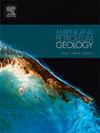Prototypical basin reconstruction and evolutionary models for the Precambrian of the Qinshui Basin, North China craton
IF 3.7
2区 地球科学
Q1 GEOSCIENCES, MULTIDISCIPLINARY
引用次数: 0
Abstract
The thick Precambrian strata in the Qinshui Basin (QB) have high potential for hydrocarbon exploration. Tectonic evolution restoration and prototype basin reconstruction are key to hydrocarbon exploration and evaluation for Precambrian strata. We studied the 2D/3D seismic data and Precambrian field outcrops of the QB to elucidate its geological attributes, major regional unconformities, tectonostratigraphic framework, tectonic evolution and prototype basin. The Precambrian strata of the QB are the sedimentary products of the continuous transgression from south to north and are more appropriately attributed to the Xiong'er Aulacogen in the Changchengian and Jixian periods. We identified six regional unconformities: the Archean or Palaeoproterozoic/Xiong'er Group, the Xiong'er Group/Chy, Chc/Chl, Chl/Jxl, the Jxl/Cambrian System, and the Ordovician/Carboniferous. Seven tectonostratigraphic units can be delineated: the Archean–Palaeoproterozoic, Xiong'er Group, Yunmengshan–Cuizhuang, Luoyukou, Jixian, Cambrian–Ordovician, and Carboniferous–Triassic tectonostratigraphic units. The tectonic evolution was divided into seven stages: the formation and evolution of the basement (∼1800 Ma), the synrift stage in the Xiong'er period (1800–1720 Ma), the postrift stage in the Yunmengshan–Luoyukou period (1720–1600 Ma), the passive continental margin basin stage in the Jixian period (1600–1400 Ma), the marine craton stage during the Cambrian–Ordovician (542–440 Ma), the marine–continental transitional–continental craton stage during the Carboniferous–Triassic (316–200 Ma), and the intense deformation stage (200–0 Ma). Three stages of prototype basin models of the Precambrian in the QB have been reconstructed: (1) In the synrift basin model, numerous normal faults have developed, and the section shows a symmetrical composite graben. The topography in the south is low, that in the north is high, and the northeast and northwest areas are palaeo-uplifted. A set of volcanic rocks with coarse-grained clasts was deposited. (2) In the postrift basin model, the fault activity weakened, and the depositional range became larger than that of the synrift stage, and a set of marine clastic–carbonate rocks was deposited showing a gradual coarsening–upwards trend. (3) In the passive continental margin basin model, the fault became almost inactive, the topography was low in the southeast and high in the northwest, and the depositional area was more widespread, resulting in a set of marine carbonates. These results contribute to a better understanding of the break-up process of the Columbia supercontinent and the Precambrian evolution of the North China Craton (NCC) and can be used to predict the distributions of source rocks and hydrocarbons.
华北克拉通沁水盆地前寒武纪盆地原型重建与演化模型
沁水盆地(QB)厚前寒武纪地层具有很高的油气勘探潜力。构造演化复原和盆地原型重建是前寒武纪地层油气勘探和评价的关键。我们研究了 QB 的二维/三维地震资料和前寒武纪野外露头,以阐明其地质属性、主要区域不整合、构造地层框架、构造演化和原型盆地。QB的前寒武纪地层是由南向北连续横断的沉积产物,归属于长城期和集贤期的熊耳坳陷更为合适。我们确定了六个区域性不整合位点,分别是:Archean 或古生代/熊耳组、熊耳组/Chy、Chc/Chl、Chl/Jxl、Jxl/寒武系以及奥陶系/石炭系。可划分出七个构造地层单元:原生-古近系、熊耳组、云蒙山-崔庄、罗峪口、蓟县、寒武-奥陶系、石炭-三叠系构造地层单元。构造演化分为七个阶段:基底的形成与演化阶段(1800Ma∼1800Ma)、熊耳期的同步漂移阶段(1800-1720Ma)、云蒙山-骆鱼口期的后漂移阶段(1720-1600Ma)、集贤期的被动大陆边缘盆地阶段(1600-1400Ma)、寒武-奥陶纪(542-440Ma)的海相克拉通阶段、石炭-三叠纪(316-200Ma)的海陆过渡-大陆克拉通阶段以及强烈变形阶段(200-0Ma)。重建了 QB 前寒武纪三个阶段的盆地模型原型:(1) 在同步漂移盆地模型中,大量正断层发育,断面呈对称的复合地堑。南部地势较低,北部地势较高,东北部和西北部地区为古隆起。沉积了一套带有粗粒碎屑的火山岩。(2) 在后断裂盆地模型中,断层活动减弱,沉积范围大于同步断裂阶段,沉积了一套海相碎屑岩-碳酸盐岩,呈逐渐粗化向上的趋势。(3) 在被动大陆边缘盆地模型中,断层几乎不活动,地形东南低西北高,沉积范围更广,形成一套海相碳酸盐岩。这些结果有助于更好地理解哥伦比亚超大陆的断裂过程和华北克拉通的前寒武纪演化过程,并可用于预测源岩和碳氢化合物的分布。
本文章由计算机程序翻译,如有差异,请以英文原文为准。
求助全文
约1分钟内获得全文
求助全文
来源期刊

Marine and Petroleum Geology
地学-地球科学综合
CiteScore
8.80
自引率
14.30%
发文量
475
审稿时长
63 days
期刊介绍:
Marine and Petroleum Geology is the pre-eminent international forum for the exchange of multidisciplinary concepts, interpretations and techniques for all concerned with marine and petroleum geology in industry, government and academia. Rapid bimonthly publication allows early communications of papers or short communications to the geoscience community.
Marine and Petroleum Geology is essential reading for geologists, geophysicists and explorationists in industry, government and academia working in the following areas: marine geology; basin analysis and evaluation; organic geochemistry; reserve/resource estimation; seismic stratigraphy; thermal models of basic evolution; sedimentary geology; continental margins; geophysical interpretation; structural geology/tectonics; formation evaluation techniques; well logging.
 求助内容:
求助内容: 应助结果提醒方式:
应助结果提醒方式:


